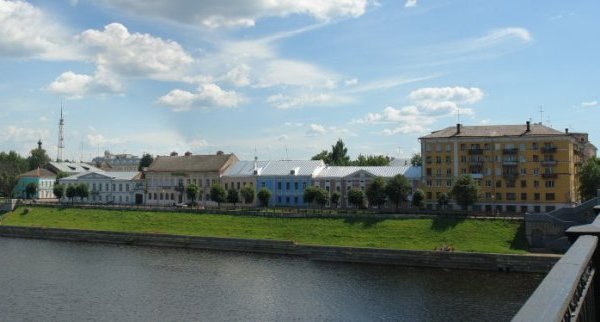

Embankment of Stepan Razin is
situated on the right bank of Volga river in the historic center of
Tver. It is situated between Volny Novgorod (Free Novgorod) street
and Svobodny pereulok (Freedom street). It consists of several
buildings, most of which date back to the 18th and 19th centuries.
Several buildings were constructed during Stalin's period. The
design of embankment belongs to city architect P.R. Nikitin.
Embankment was named after famous Russian rebel Stepan Razin who
headed one of the largest rebellions against Moscow tsars and rich
land owners in the middle of the 17th century.
House #1-
Theater "Zvezda". Constructed in 1930's by architecct V.P. Kalmykov
House #2- Hotel of Military Academy of G.K. Zhukov. Constructed for
voroschilovsky strelki (Voroshilov's shooters or simply
sharpshooters). Constructed in 1936 by architect I.S. Yurmanov.
House #3 Tver branch of Judicial branch of the government
House
#4 House of tsar's civil official I.M. Panov
House #5 Former
house of Tver's mayor A.F. Golovinsky that lived here in 1843- 71.
House #23 Paediatrics Tver Oblast Hospital. Former women's school
that was built in 1889- 1900 by architect V.I. Nazarin.
The beautiful embankment in Tver is located on the
right bank of the Volga, going from the city garden to the stadium.
It is named after the Don Cossack Stepan Razin. Back in the middle
of the 18th century, stone houses began to appear on the embankment.
They stood tightly to each other on the principle of one facade -
this style was used in St. Petersburg. However, merchants who wanted
more personal space opposed such development. The entrepreneurs
defended their right to the territory, and the embankment remained
so - in the St. Petersburg style.
In the 30s of the last
century, the embankment had to be protected from erosion - the water
level rose so high that part of the city could be in the river. If
this happened, then Tver would have lost its interesting buildings.
For example, the estate of Khozinsky or several stone houses of the
18th century. The latter have come down to us almost unchanged,
namely in the style of "single facades".
Until the end of the
18th century, many sections of the Razin embankment were one-story,
but later received second floors. No, but protection from the Volga.
Unfortunately, today the embankment is not in the best condition,
but it still remains a favorite place for walking in Tver people.